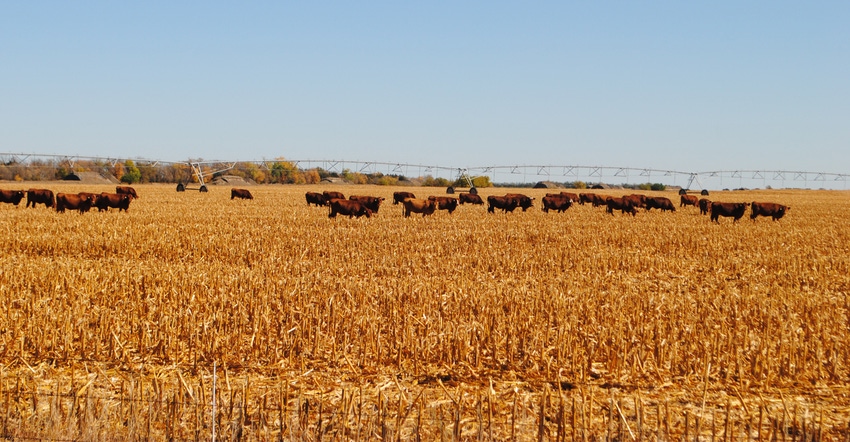
The elephant in the room when we are talking about grazing cornstalks in the late fall and winter months is, of course, compaction issues. Landowners with cornstalks to rent or graze themselves still carry some apprehension at times about the effect of potential compaction on next year’s crop from the hoof action of cattle.
However, a long-term and well-documented study in eastern Nebraska at the Eastern Research and Extension Center showed a 2- to 3-bushels-per-acre improvement for soybean production the year following grazed cornstalks in a normal corn-soybean crop rotation.
In a University of Nebraska news release written by Nebraska Extension specialists Daren Redfearn, Mary Drewnoski and Jay Parsons, it was noted that this same result came whether the cattle were grazing residue in the fall from November through January, or in the late winter and early spring from February through April.
Another five-year study in western Nebraska at Brule — on a continuous corn cropping system after cattle grazed corn residue in the fall — showed there were no negative effects on corn yields the next year.
Minor compaction of surface soils occurs. This cannot be denied, especially during wet weather, and producers can expect a little surface roughness due to grazing. But the natural wetting and drying and freezing and thawing processes mitigate that minor compaction, and it does not carry over into the next cropping season.
Corn production of 150 bushels per acre produces about 3 tons per acre of residue. Corn crops yielding 200 bushels per acre will produce more than 4 tons. Of this residue, Nebraska Extension specialists say that 40% is leaf and husk, which is highly digestible by cattle.
Stocking rate
On the benefit side, another news release from the same Nebraska Extension specialists digs into the details on why these long-term studies are so significant and the role of stocking rate on the overall results. Proper stocking rates should ensure little to no effect on subsequent crops.
Stocking rates are based on 50% utilization of leaves and husks, which amounts to about 8 pounds per bushel or 20% of the total crop residue. Wind and trampling will remove additional residue, but there are no erosion concerns when only 40% to 50% of the corn residue is removed through grazing.
With an abundance of corn residue across the state, this is one of the state’s great cropping resources that benefit cattle. Another bonus is an increase in the soil microbial community that was observed compared to areas that are not grazed. This may explain the improvement in soybean yields after grazing.
While many may be concerned about a reduction in soil organic matter due to grazing, the long-term studies suggest no difference in soil organic matter, nitrogen, potassium or phosphorus, because most of the nutrients consumed by cattle are excreted on the land.
If land is sloping or in areas where corn yields are typically low, cattle should be held off because there isn’t enough crop residue to provide adequate cover for the land.
Finding stalks to graze
The Nebraska Extension Crop Residue Exchange can link those landowners with stalks to rent out and growers who are looking for residue to graze. With drought conditions across the northern Great Plains, this can be an extremely useful tool in finding feed for cattle. To get started with this online tool, establish a login account.
Once that is done, farmers are able to list cropland available for grazing by drawing out the plot of land available using an interactive map and entering basic information about the type of residue or forage, fencing situation, water and date they are available. The mapping tool listings include all of Nebraska and much of adjacent states, including Iowa, Missouri, Kansas Colorado, Wyoming and South Dakota.
The land and residue available are listed within the exchange by residue type, including corn, wheat, sorghum, pasture or other. Pricing can be listed as cost per acre or cost per head per day. Farmers list their own preferred contact information.
Livestock producers looking for residue to graze can search the exchange database for grazing available within a radius from the location they are interested in, but they must be logged in to view the contact information from each listing. If you’ve used the tool in previous years, you need to log in and update your listings for the 2021-22 fall and winter grazing period.
Learn more at cropresidueexchange.unl.edu. This exchange is made possible with funding support from Nebraska Extension, Northern Plains Climate Hub and UNL IANR Beef Systems Initiative.
About the Author(s)
You May Also Like






